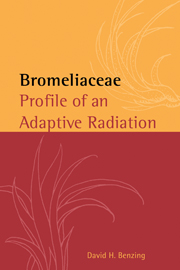Book contents
- Frontmatter
- Contents
- List of contributors
- Preface
- Acknowledgments
- Glossary
- Abbreviations
- Part one Brief overview
- Part two Basic structure, function, ecology and evolution
- Part three Special topics
- 10 Neoregelia subgenus Hylaeaicum
- 11 Cryptanthus
- 12 Tillandsioideae
- 13 Tillandsia and Racinaea
- 14 Ethnobotany of Bromeliaceae
- 15 Endangered Bromeliaceae
- Literature cited
- Name index
- Subject index
- Taxon index
15 - Endangered Bromeliaceae
from Part three - Special topics
Published online by Cambridge University Press: 19 January 2010
- Frontmatter
- Contents
- List of contributors
- Preface
- Acknowledgments
- Glossary
- Abbreviations
- Part one Brief overview
- Part two Basic structure, function, ecology and evolution
- Part three Special topics
- 10 Neoregelia subgenus Hylaeaicum
- 11 Cryptanthus
- 12 Tillandsioideae
- 13 Tillandsia and Racinaea
- 14 Ethnobotany of Bromeliaceae
- 15 Endangered Bromeliaceae
- Literature cited
- Name index
- Subject index
- Taxon index
Summary
The rapid and accelerating destruction of the world's tropical forests is widely known. Less appreciated are two additional facts: half of the estimated 300000 species of higher plants occur in these biomes, and epiphytes make up to half of the vascular floras of certain tropical forests (Benzing 1990). Moreover, bromeliads comprise most of the biomass of arboreal vegetation at many wet montane tropical American sites. Because members of this family significantly influence important forest processes and provide substrates and other resources for much canopy-based fauna, their preservation is vital to broader conservation efforts. Terrestrial Bromeliaceae, about half of the family, sometimes dominate communities where climates are harsh (e.g., cool or hot and dry) or substrates (e.g., rock) mandate unusual plant adaptations to obtain nutrients and water (Chapters 4 and 5). Too little information is available in the literature on the sizes and genetic structures of bromeliad populations to determine if more than just a handful of taxa are truly endangered (Chapter 6), and thus the following discussion draws heavily on unpublished observations and findings on other taxa.
Bromeliads tend to be locally abundant if not as diverse as co-occurring, ecologically similar flora such as Orchidaceae. Individual phorophytes or rock faces routinely support hundreds to millions of adults. One of the many populations of Tillandsia purpurea in the coastal desert of Peru (Pan-American highway, kilometer 348 north) covered approximately six square kilometers at a density of ∼50 ramets per square meter to total some 300 million ramets (Dimmitt 1989a).
- Type
- Chapter
- Information
- BromeliaceaeProfile of an Adaptive Radiation, pp. 609 - 620Publisher: Cambridge University PressPrint publication year: 2000



